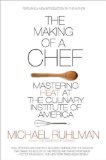I’ve mentioned before that I didn’t even really start learning to cook till I was in college, and even then it was slow going as I was neck-deep in engineering coursework. Since then, I’ve cooked almost obsessively and loved every minute of it. Even before I left my job, I considered the notion of culinary school. After a fair amount of soul-searching, I expect I’ll never go that route (mostly because I doubt I’d use it for anything other than my own enjoyment, and it’s awfully expensive). However, I needn’t forgo the experience entirely. Michael Ruhlman in The Making of a Chef invites the reader to vicariously experience a cooking school education at none other than the Culinary Institute of America.



The book is divided into sections that logically follow the path of a CIA culinary education (or at least the path as it was laid out in 1996). Part 1 – Skill Development walks you through the students’ first weeks in class. I felt that this was the most immersive section of the book. You see their daily prep lists, hear about the technique lessons they’re having pounded into their heads by diligent instructors and intense repetition, and you begin to understand how some of the individual students fail and succeed at their lessons. (This is also where Mr. Ruhlman meets Chef Uwe Hestnar and acquires his fateful sheet of culinary ratios.)
The remaining sections introduce the reader to the administration, talk about some of the higher-level courses, and follow Ruhlman and his fellow students as they work at The Culinary’s various restaurants. It also talks about the student externships – the mandatory period during which they extern at a real-world restaurant.
In reading this book, I feel I’ve learned not only about the Culinary Institute of America and what one might encounter when seeking an education there. It seems I’ve also gotten some background on one of my favorite food writers. Ruhlman’s voice in this book is one of discovery and rapt interest in his newly adopted culinary world. As always, his passion is tempered by his practicality and never is this more apparent than when he’s working through how he’ll get through his ever growing prep lists. In an intrinsic way he becomes part of the kitchen machine with tasks scrolling through his brain click-click-click till at the end of the class period he seems exhausted but utterly satisfied with the crazy work he has undertaken.
Has this book made me change my mind and want to rush off to culinary school? Not necessarily, but it has given me a relentless desire to make a respectably clear chicken stock and my own mother sauces. It has also sprouted a desire to read Ruhlman’s follow-up book The Soul of a Chef: The Journey Toward Perfection